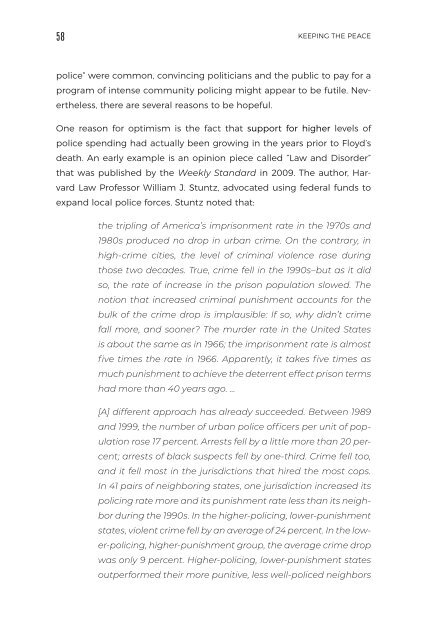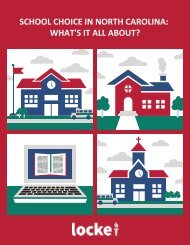Keeping the Peace Through Intensive Community Policing
As crime soars and the breakdown of public order takes its toll on our country, analysis from the John Locke Foundation signals it’s time to adopt a different approach to crime control, one that shifts the focus further upstream, looking at prevention models, rather than exclusively on punitive measures. In this July 2021 report, John Locke Foundation researcher and author Jon Guze explains that the current focus of catching, convicting, and punishing perpetrators after crimes have been committed has come with enormous economic and social costs. However, intensive community policing has proven successful at deterring crime and maintaining order, which leads to safer communities and fewer people living in poverty. Guze recommends a four-pronged plan to move forward with community policing: (1) hire more police officers (2) increase the pay for police officers (3) arm police officers with state-of-the-art training, direction, and support (4) deploy police officers as “peacekeepers” in communities that suffer most from crime and disorder.
As crime soars and the breakdown of public order takes its toll on our country, analysis from the John Locke Foundation signals it’s time to adopt a different approach to crime control, one that shifts the focus further upstream, looking at prevention models, rather than exclusively on punitive measures. In this July 2021 report, John Locke Foundation researcher and author Jon Guze explains that the current focus of catching, convicting, and punishing perpetrators after crimes have been committed has come with enormous economic and social costs.
However, intensive community policing has proven successful at deterring crime and maintaining order, which leads to safer communities and fewer people living in poverty. Guze recommends a four-pronged plan to move forward with community policing:
(1) hire more police officers
(2) increase the pay for police officers
(3) arm police officers with state-of-the-art training, direction, and support
(4) deploy police officers as “peacekeepers” in communities that suffer most from crime and disorder.
Create successful ePaper yourself
Turn your PDF publications into a flip-book with our unique Google optimized e-Paper software.
58 KEEPING THE PEACE<br />
police” were common, convincing politicians and <strong>the</strong> public to pay for a<br />
program of intense community policing might appear to be futile. Never<strong>the</strong>less,<br />
<strong>the</strong>re are several reasons to be hopeful.<br />
One reason for optimism is <strong>the</strong> fact that support for higher levels of<br />
police spending had actually been growing in <strong>the</strong> years prior to Floyd’s<br />
death. An early example is an opinion piece called “Law and Disorder”<br />
that was published by <strong>the</strong> Weekly Standard in 2009. The author, Harvard<br />
Law Professor William J. Stuntz, advocated using federal funds to<br />
expand local police forces. Stuntz noted that:<br />
<strong>the</strong> tripling of America’s imprisonment rate in <strong>the</strong> 1970s and<br />
1980s produced no drop in urban crime. On <strong>the</strong> contrary, in<br />
high-crime cities, <strong>the</strong> level of criminal violence rose during<br />
those two decades. True, crime fell in <strong>the</strong> 1990s–but as it did<br />
so, <strong>the</strong> rate of increase in <strong>the</strong> prison population slowed. The<br />
notion that increased criminal punishment accounts for <strong>the</strong><br />
bulk of <strong>the</strong> crime drop is implausible: If so, why didn’t crime<br />
fall more, and sooner? The murder rate in <strong>the</strong> United States<br />
is about <strong>the</strong> same as in 1966; <strong>the</strong> imprisonment rate is almost<br />
five times <strong>the</strong> rate in 1966. Apparently, it takes five times as<br />
much punishment to achieve <strong>the</strong> deterrent effect prison terms<br />
had more than 40 years ago. ...<br />
[A] different approach has already succeeded. Between 1989<br />
and 1999, <strong>the</strong> number of urban police officers per unit of population<br />
rose 17 percent. Arrests fell by a little more than 20 percent;<br />
arrests of black suspects fell by one-third. Crime fell too,<br />
and it fell most in <strong>the</strong> jurisdictions that hired <strong>the</strong> most cops.<br />
In 41 pairs of neighboring states, one jurisdiction increased its<br />
policing rate more and its punishment rate less than its neighbor<br />
during <strong>the</strong> 1990s. In <strong>the</strong> higher-policing, lower-punishment<br />
states, violent crime fell by an average of 24 percent. In <strong>the</strong> lower-policing,<br />
higher-punishment group, <strong>the</strong> average crime drop<br />
was only 9 percent. Higher-policing, lower-punishment states<br />
outperformed <strong>the</strong>ir more punitive, less well-policed neighbors











